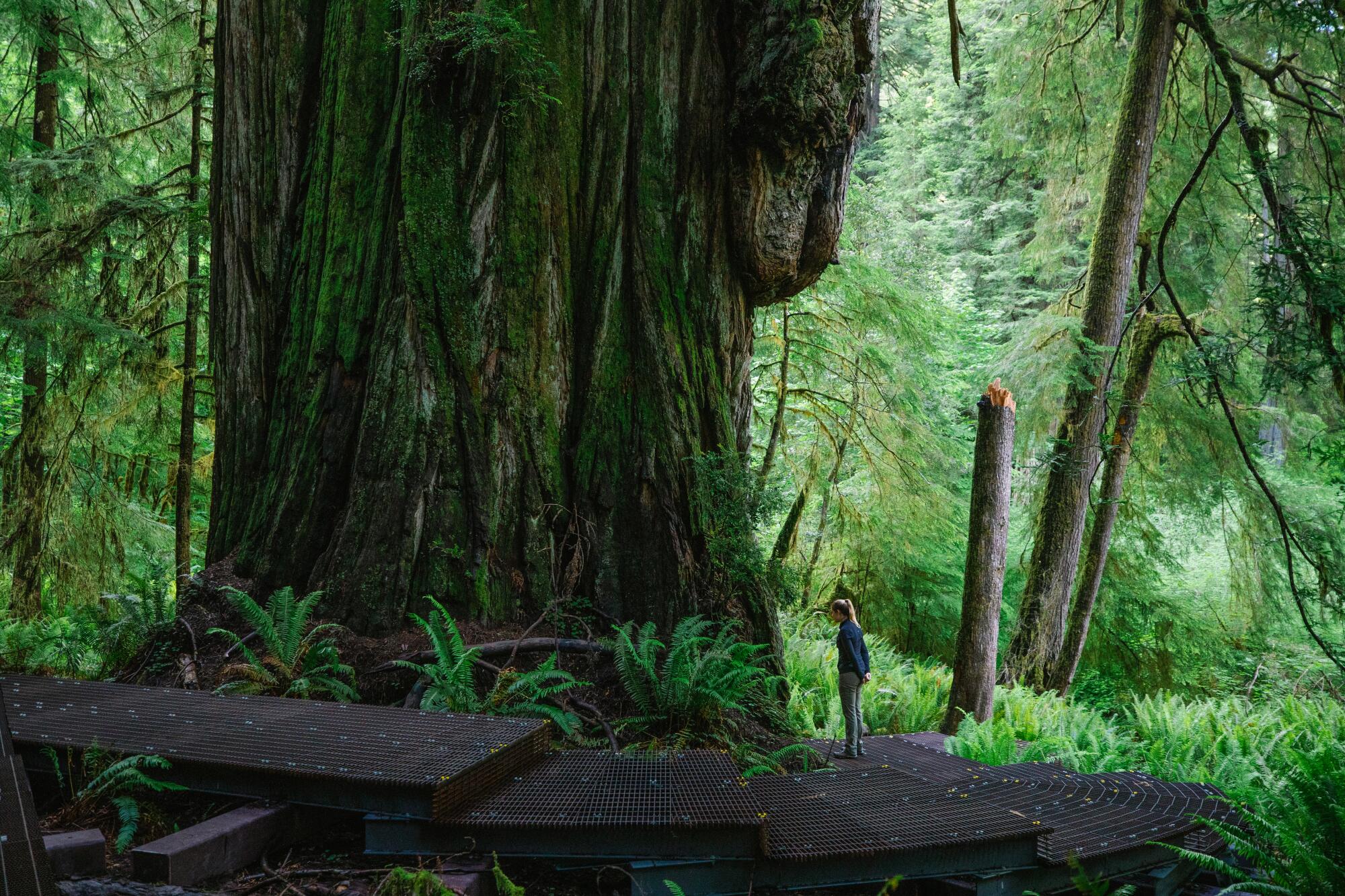
- Share via
You seem to be shrinking. You’re hiking through dense Northern California greenery, passing from a dirt path to an elevated walkway. And the trees are getting taller.
Somewhere nearby, a bird calls and Mill Creek burbles. But those elements are only bit players in this drama. The main attractions rise up around you in daunting clusters: redwoods, implausibly tall, imponderably old and, until recently, a secret.
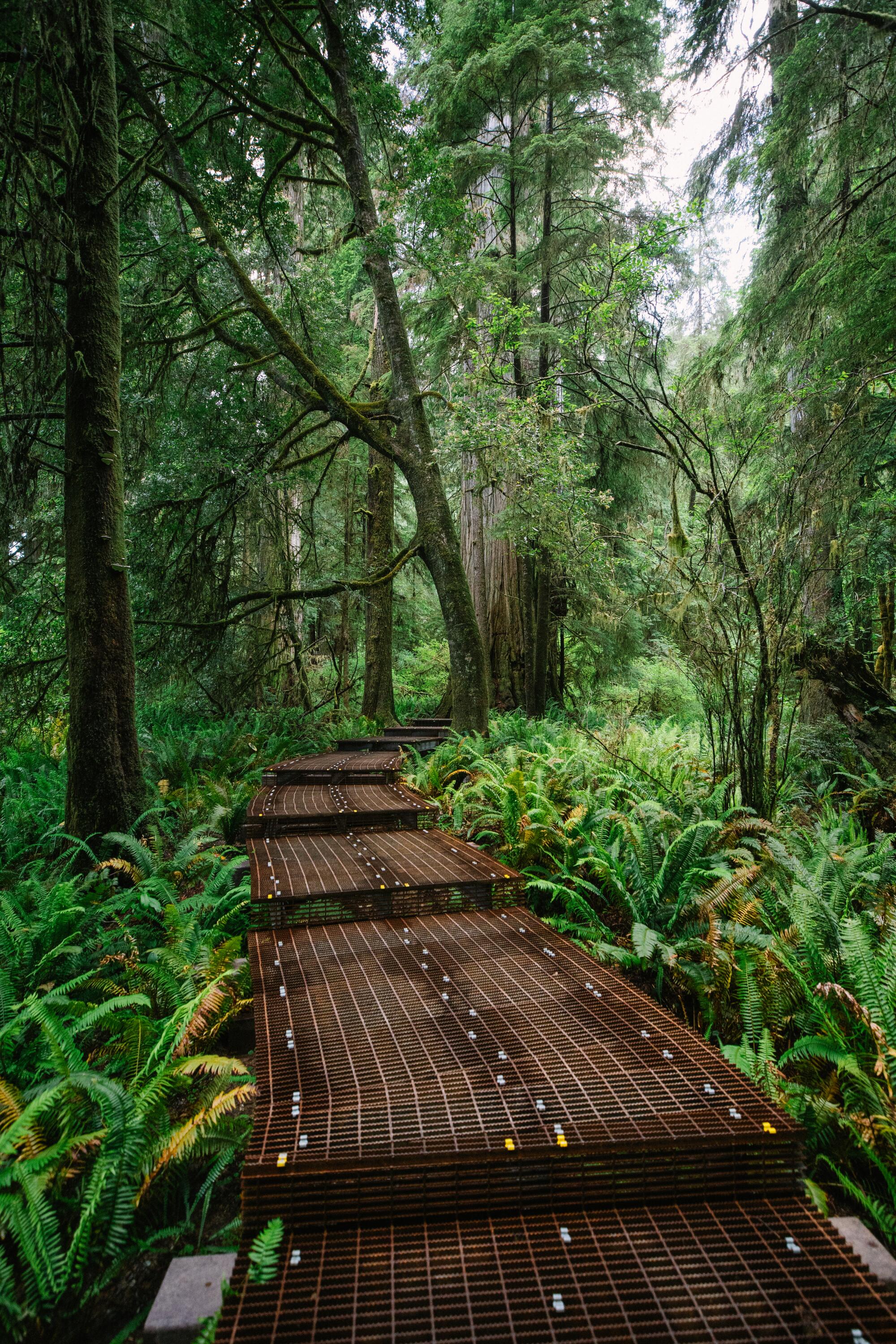
This is the Grove of Titans, a roughly 3-acre patch of parkland near the California-Oregon border that holds some of the planet’s tallest trees. To enter, you step on to the three-mile Mill Creek Trail, newly rerouted and ready for summer visitors. For a writer from Southern California, this place isn’t just wetter. It seems to operate on different principles of time and size too.
This is not the only spellbinding redwoods hike in the rainforests of Del Norte and Humboldt counties, or even the only redwood trail in Jedediah Smith Redwood State Park, but it has a story like no other.
In mid-June, I walked the trail with Erin Gates, acting deputy superintendent of Redwood National and State Parks, to talk about the grove’s odd history and the challenge it poses to hikers and rangers.
“This forest is different from the redwood forests in Big Sur or Santa Cruz. Everything is more magnified. The ferns are bigger. The trees feel bigger. It feels like you’re in prehistoric times. Look at how many shades of green you’re seeing, just standing here,” she said.

Many of the trees rise more than 300 feet from the damp, uneven ground. Sometimes three or four trunks spread and rise from a single base. Some trunks sprout straight up from the sides of trees that fell long ago. I paused at one tree with blackened bark.
“This looks recent,” I said.
No, said Gates. That fire happened more than 170 years ago.

Subscribers get exclusive access to this story
We’re offering L.A. Times subscribers special access to our best journalism. Thank you for your support.
Explore more Subscriber Exclusive content.
Rangers say many of these trees are more than 1,300 years old. Some may be more than 2,000.
“It’s so green!” said Kate Melbye, 16, visiting from Wisconsin, as she passed on the trail.
“The banana slugs!” said her sister, Ally Melbye, 11. (They’re yellow, several inches long, and they come out after rain, which is often.)

These woods have been part of Jedediah Smith Redwoods State Park since the park’s creation in 1929, and part of Redwood National and State Parks since 1994. Yet this grove — 3 acres in a 10,000-acre park — was unknown to experts until 1998.
That’s when rainforest-roaming redwood experts Stephen C. Sillett, a professor at Humboldt State University, and Michael W. Taylor found it, chose the name Grove of Titans and bestowed equally portentous names upon the largest of the trees. Screaming Titans. Lost Monarch. El Viejo del Norte.
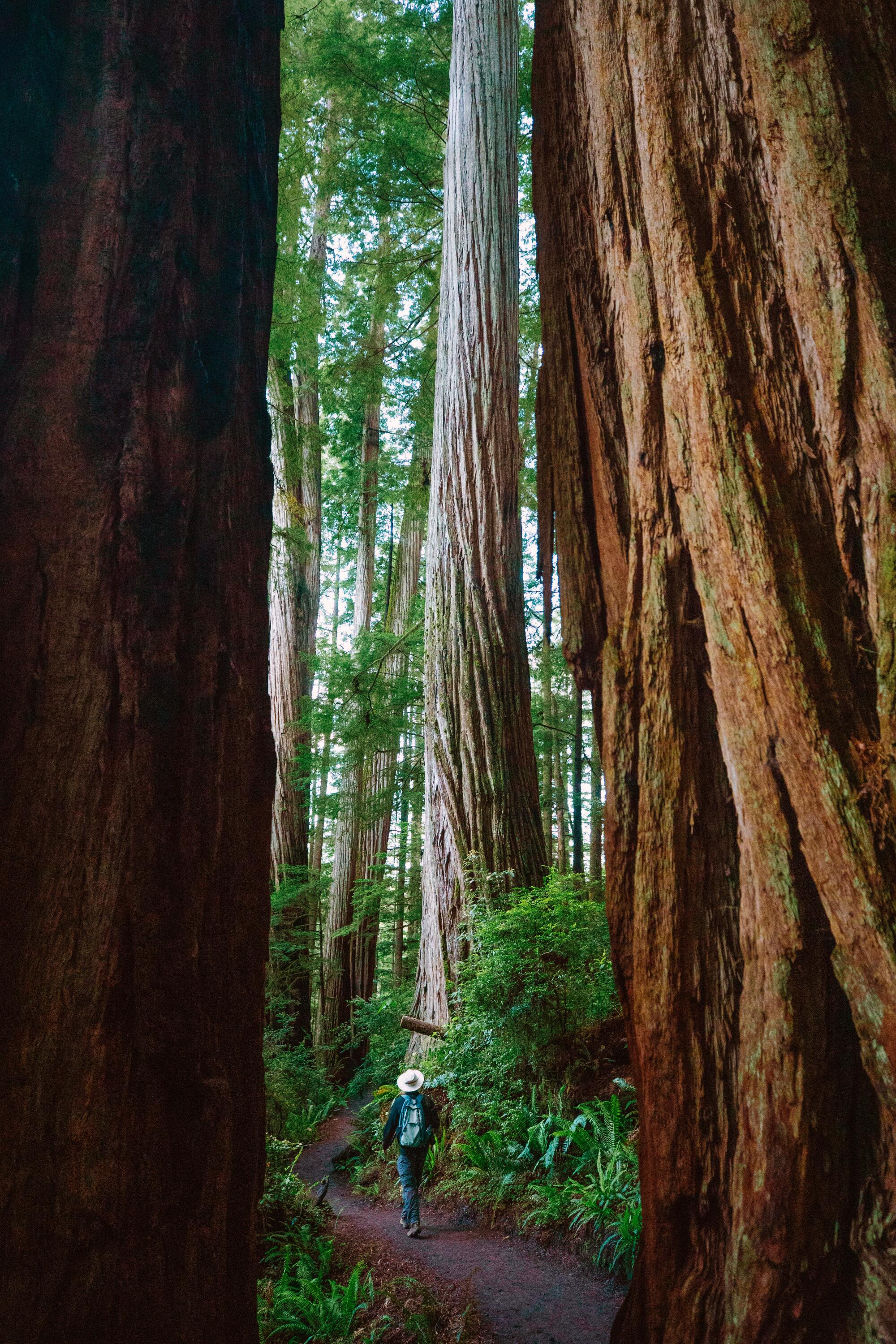
When author Richard Preston described the men’s discovery in his widely acclaimed book “The Wild Trees” in 2007, he didn’t disclose the grove’s specific location for fear of the damage that might follow. Rangers kept the secret too, thinking of the redwoods’ shallow, vulnerable roots and the grove’s “understory” foliage.
“We would basically pretend like it didn’t exist,” Gates said. Even now, the most recent park brochures say nothing about the Grove of Titans.
But the internet says plenty.
About 11 years ago, someone posted the grove’s GPS coordinates. Soon rangers were finding a warren of “social trails” — bushwhacked by tree seekers — in the area. Still the rangers kept mum (just as they keep mum about the location of Hyperion, the tallest known tree on Earth), hoping the traffic would fade away. Instead it grew.
“We saw almost irreparable damage happening to some of the forest floor in less than a decade,” Gates said.
This put the rangers in a tough spot. They’re supposed to provide access to public lands but they’re also supposed to protect old-growth forests that have already been 95% destroyed by logging.
As for the letter of the law, in most cases, it’s not illegal to hike off-trail in a California state park, but “disturbance or destruction” of natural scenery, plants and animal life “is strictly forbidden.”
The park officials’ answer: Reroute an old trail to run through the grove — and build a quarter-mile elevated metal walkway that protects the most vulnerable forest floor from footprints while allowing sunlight and moisture in. This way, hikers need not blaze their own forest-damaging pathways. If people stay on the new trail, everybody wins.
A crew began work on Mill Creek Trail in late 2019, taking elaborate steps to protect the forest while they built.
“They ended up hand-carrying over 128 tons of material,” Gates said.
The trail’s elevated portion, which begins about three-quarters of a mile beyond the Mill Creek trailhead, was completed in September 2021, along with a set of restrooms. The next two miles of the three-mile rerouted trail — now wider, with footbridges, retaining walls and reminders to stay on trail — is due for completion in midsummer.
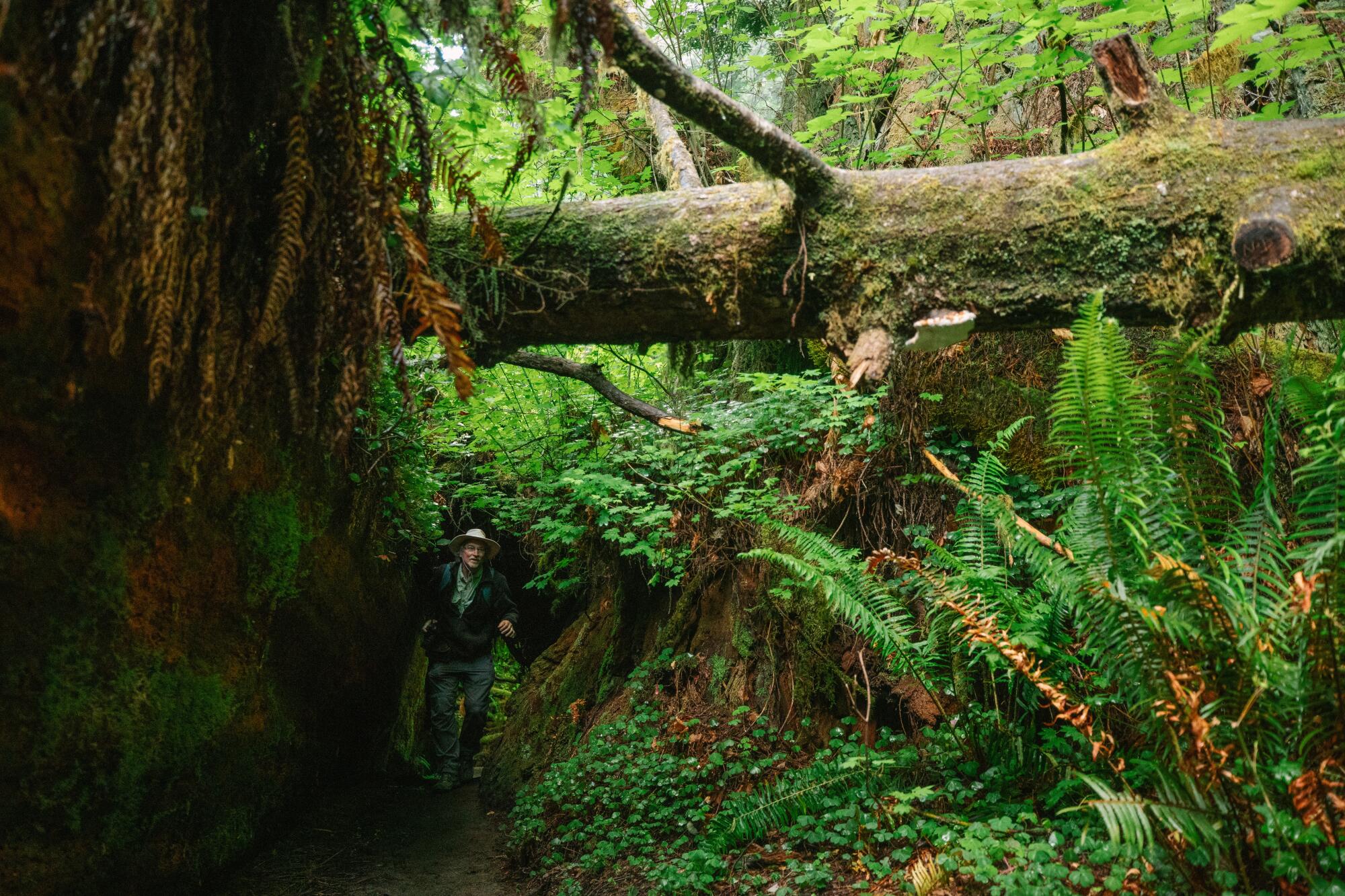
New signs explain the ecosystem and acknowledge that the area is part of the ancestral lands of the Tolowa Dee-ni’ Nation. The Save the Redwoods League and Redwood Parks Conservancy contributed much of the project’s $4-million cost.
Gates said the trail crew probably will apply finishing touches by the end of July. But the reviews from hikers are coming in already.
“My necks hurts from looking up,” said David Ogden, 27, from Ohio, beaming.
“Breathtaking,” said Kolton Wilson, 30, also of Ohio.
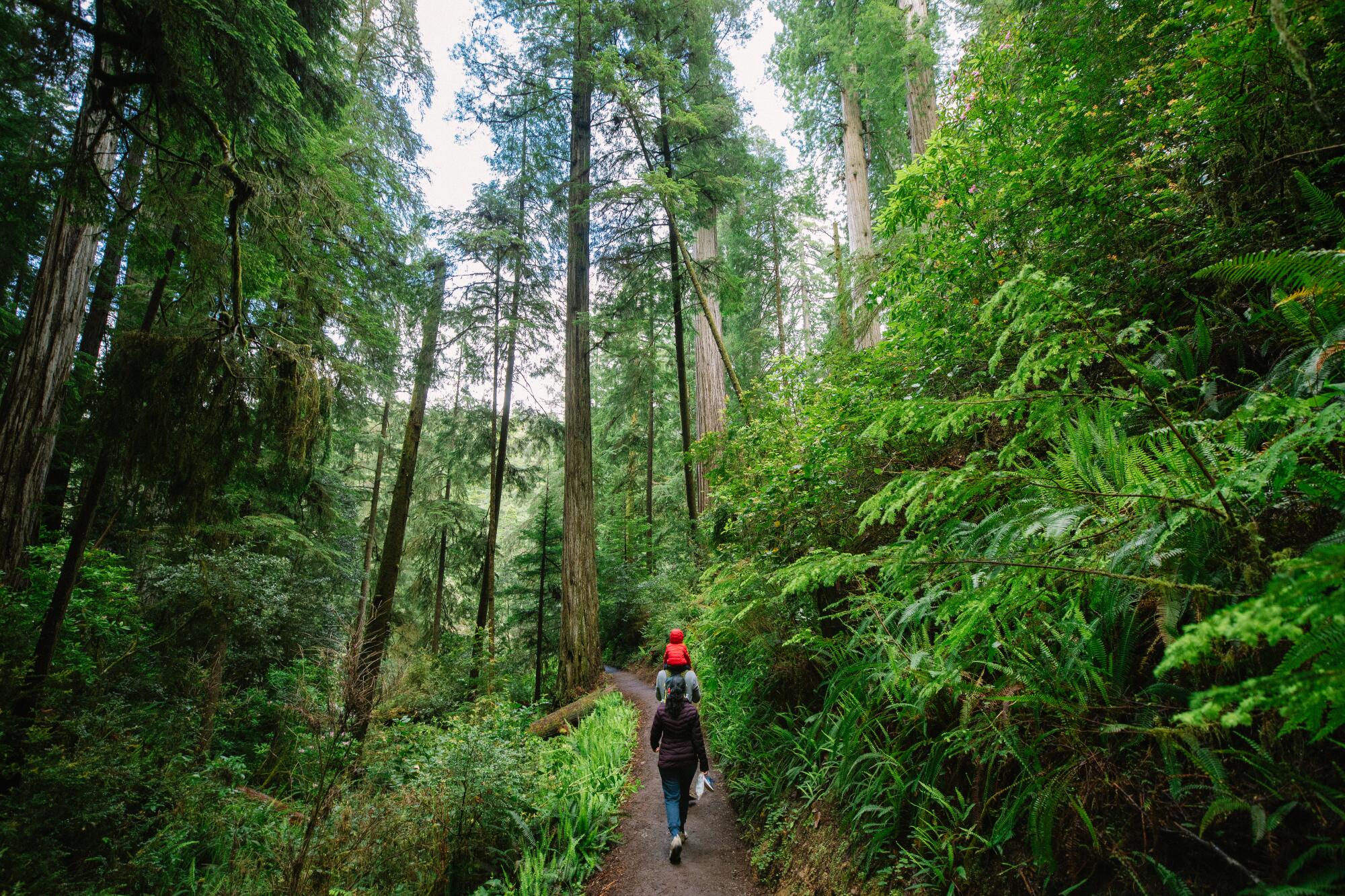
Mill Creek Trail and Grove of Titans require no reservations, and they’re free. In May, rangers counted 380 cars per day traveling on Howland Hill Road toward the grove from Crescent City.
Besides the redwoods, visitors find enough species to populate a botanist’s fever dream, including big leaf maple trees, Douglas fir, Western hemlock, grand fir, California bay and Sitka spruce trees, with sword ferns, trillium, azaleas and orchids below.

Besides banana slugs, black bears, Roosevelt elk and rough-skinned newts pass through, though we didn’t encounter any on this day. (The next day, we came across more than a dozen lounging elk in Prairie Creek Redwoods State Park.)
The professional trailblazers clearly had fun rethreading the Mill Creek Trail around and between the behemoths. Here and there, you walk under fallen trunks. At one point you enter a dark tunnel of foliage beside a toppled tall tree, then emerge again, buffeted by fern fronds.
Still, on the path, I couldn’t help wondering: What if people follow this revised trail into the grove, then hop off path to hug more trees and pose for more selfies?
It’s already happening, Gates told me.

“We built this to allow people to get close, and we can see where it’s growing back, the ferns and the sorrel. But you can see where they are not growing back. People are trampling again.”
In a separate conversation, Gates added that most people “are not doing this out of malice. It’s done out of ignorance. They’re thinking on an individual level rather than a collective level.”
To tamp down that behavior, park officials are recruiting “Titaneers” — volunteers who will walk the trail with radios (and uniforms from REI). And they may add more signs asking people to stay on the trail.
“But do you over-sign a place like this?” Gates asked, spreading her arms to indicate the vast canopy.
If you get to the Grove of Titans this summer, you’ll be doing yourself a favor. If you stay on trail, the rangers say, you may be doing one for your kids’ kids.
If you go: Grove of Titans in Jedediah Smith Redwoods State Park
Getting there
From Los Angeles, the quickest way to reach Jedediah Smith Redwoods State Park — and all of Del Norte County — is flying Avelo Airlines from Burbank to the Arcata/Eureka Airport in McKinleyville; or flying United Express from Los Angeles International to Arcata/Eureka. Those flights take less than two hours. From the Arcata/Eureka airport (which has rental cars), it’s 70 driving miles north to Crescent City and the Jedediah Smith Redwoods State Park Visitor Center.
The Mill Creek Trail is in Jedediah Smith Redwoods State Park, 1440 Highway 199, Crescent City; (707) 465-7335. If you’re not up for hiking, you might still want to drive the unpaved portion of Howland Hill Road, a wriggling route that’s six miles long and began as a 19th century stagecoach path. Often muddy and unfailingly atmospheric, it weaves narrowly between big trees.
Where to sleep
There are several budget hotels and motels in Crescent City. I stayed along U.S. Highway 101 at the Curly Redwoods Lodge, which was built in 1952 using lumber from a single redwood tree (there are photos). It’s a mix of Midcentury Modern and lumberjack kitsch. My basic room cost $153.37 after taxes.
Where to eat
Bring snacks. Dinner options in Crescent City and Klamath to the south are few and far between, especially on Sundays and Mondays. Even the Crescent City Denny’s (1225 5th St., Crescent City) closes at 9 p.m. For one dinner I ended up at Burger King (1250 9th St., Crescent City; (707) 464-1714). For breakfast, Good Harvest Cafe (575 U.S. Highway 1 South, Crescent City; (707) 465-6028) served hearty portions.
While you’re there
- Don’t miss Crescent City’s Battery Point Lighthouse, which stands on a tidal island, dates to 1856 and survived the great tsunami of 1964. It’s a handsome building along a gorgeous stretch of coastline. If you get to the parking lot at Battery and B streets at low tide, you can walk to the lighthouse. Just be sure to return before the water rises and surrounds the island again. Tide permitting, it’s open daily 10 a.m.-4 p.m. April through September.
- If you’re traveling with children, you may want to leave time for Trees of Mystery, an old-school roadside attraction that features an elevated Redwood Canopy with suspension bridges and platforms, strangely shaped redwoods and a 49-foot-tall Paul Bunyan (who has been known to speak).
- To spend time on the water and hear a native perspective on the area, head for Klamath (22 miles south of Crescent City and 48 miles north of the Arcata/Eureka airport), where Yurok tribe guides offers summertime tours on the Klamath River in traditional redwood canoes (two hours or four hours). Two-hour jet boat tours are also available.
- For more hiking and more park attractions, Prairie Creek Redwoods State Park, whose visitor center is 34 miles north of the Arcata/Eureka airport and 34 miles south of Crescent City, includes miles of redwood forest and wild coastline, including the 10-mile Newton B. Drury Scenic Parkway, the Elk Prairie Campground (where elk often gather) and the Fern Canyon Loop Trail (reservations required). Since 1994, federal and state officials have run Redwood National and State Parks as a cooperative entity that includes Del Norte Coast Redwoods State Park, Jedediah Smith Redwoods State Park and Prairie Creek Redwoods State Park.
More to Read
Sign up for This Evening's Big Stories
Catch up on the day with the 7 biggest L.A. Times stories in your inbox every weekday evening.
You may occasionally receive promotional content from the Los Angeles Times.







